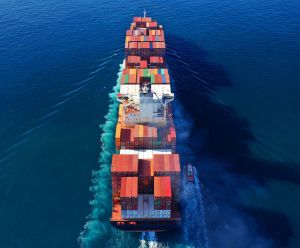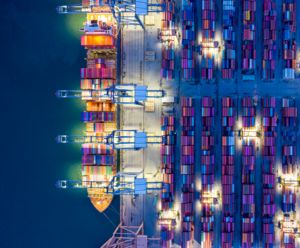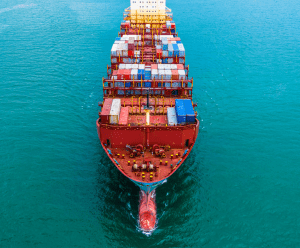
Container shipping: Keep Calm and Carry On

It might seem like the world is in flux, but container shipping is going through a form of normalization right now.
This may seem strange, given that as February turned to March, Red Sea diversions of vessels around the Cape were still causing myriad supply chain ructions. Yet, the industry is coping well, compared to the chaos witnessed when the Ever Given blockage of the Suez Canal in 2021 added to Covid-driven ocean shipping anarchy.
In fact, this Suez Canal black swan has been nurtured and becalmed about as effectively as could be wished for by carriers. Or, to put it another way, if this iteration of supply chain disruption were British, its catchphrase would be: Keep Calm and Carry On.
This is not to say that the Red Sea crisis is not driving container markets in many ways, as it continues to threaten capacity and equipment shortages. Cape diversions and incremental capacity needed to connect to the Red Sea and Mediterranean ports are now soaking up more than seven percent of the global containership fleet, according to Linerlytica. It also still drives up charter rates as carriers seek to bolster capacity.
But as we pull out of the Lunar New Year demand lull, ocean freight markets look relatively serene. Carriers have re-established networks rapidly, and many are taking succor from the far higher profits they are currently generating than would otherwise have been possible, considering that a container shipping market without Cape diversions is a market with far too much capacity.
The March edition of DHL’s Ocean Freight Market Update noted that inventory-to-sales ratio is declining, driven by wholesalers reducing inventories, as retailers increase their inventories. Some carriers are even committing to vessel delivery up to 6 months in advance, showing confidence in the market.
“Market sentiment remains positive following the Lunar New Year break, as carriers are keeping rate gains and expecting tight capacity in March due to extended effects of the Red Sea diversions. Carriers have adapted to the rerouting of cargo, and many shippers took advantage of the Lunar New Year to relieve them of their backlogged inventory, so we are seeing the situation slowly normalizing,” said Niki Frank, CEO, DHL Global Forwarding Asia Pacific.
The Journal of Commerce reported that the Asia-Europe ocean trade had settled into a new normal of extended transit times, adding that while vessel schedules have been heavily affected by the diversions around southern Africa, the longer transits are — so far — not leading to congestion at European destinations.
In late February and early March, the Shanghai Containerized Freight Index (SCFI) continued to shed pre-Lunar New Year gains. Still, carriers failed to push through 1 March trans-Pacific General Rate Increases. However, the SCFI remained 96 percent higher in the first week of March than it was in December last year, according to Lynerlitica.
Calm before the storm?
There was also little sign of a major cargo demand rebound post-Lunar-New-Year. Until demand picks up on key trade lanes, major moves in the markets seem unlikely. But it would not take much more than a rise in port congestion at a major hub to throw a spanner into “stretched” global networks.
Jeremy Nixon, chief executive of Japan’s Ocean Network Express (ONE), said shipping lines were still facing scheduling issues. “Everybody is struggling with schedule integrity and therefore, we’re getting berthing clashes in a number of ports,” he told the Financial Times.
Nixon noted that there was also extra pressure on crucial hub ports, such as Singapore, Dubai, and ports around the Gibraltar Strait. “What we see is increased volumes into the hub ports in Asia and the hub ports in the Mediterranean,” he added.
Questioning alliances
Liners do have other pressing strategic issues on their plates because looming changes to the alliance system will require major network revamps in the coming months.
In January 2025, the 2M alliance between Maersk and Mediterranean Shipping Company (MSC) ends. Next February, Maersk’s new agreement with Hapag Lloyd, branded the Gemini Cooperation, enters effect.
These realignments have left other carriers with major quandaries, not least THE Alliance, which without Hapag Lloyd, loses substantial market heft on the trans-Pacific and Asia-Europe lanes.
Rumors that its remaining members – Yang Ming, HMM and ONE – might poach one of the OCEAN Alliance partners – Compagnie Maritime D'Affretement Compagnie Générale Maritime (CMA CGM), China Ocean Shipping Company, Limited (COSCO), Orient Overseas Container Line (OOCL), and Evergreen – were firmly scotched in late February, however, when its existing members extended the vessel sharing agreement until 31 March 2032.
The carrier partners said that with the confirmation of at least five years’ cooperation extension, they would like to deliver a clear and positive signal to their customers. The statement was also a firm signal of unity to other carriers, not least THE Alliance.
Looking to Gemini to calm the waters
The ambitions of the Gemini Cooperation are particularly intriguing for liner customers. DHL’s March Ocean Freight Market Update noted that the two carriers have pledged to establish a ‘hub and spoke’ network with limited port calls on deep-sea loops and include coverage of Europe - Middle East - Indian Subcontinent trade besides the East-West trades.
The Gemini Cooperation will operate 26 mainline services and have dedicated regional shuttles in Europe, the Middle East, Asia Pacific, and the United States (U.S.) Gulf.
Maersk will contribute 60 percent of the Gemini tonnage, while Hapag-Lloyd will provide the remaining 40 percent, resulting in a combined capacity of 3.4 million TEU. This will make 'Gemini' the second-largest global container shipping alliance, trailing behind the Ocean Alliance, and surpassing MSC and THE Alliance.
For shippers, the standout feature of the Gemini Cooperation is the aim to achieve over 90 percent schedule reliability by minimizing the number of port calls per loop, thus ensuring faster turnaround.
Even attempting such a target will put pressure on other carriers. However, the target will be difficult to achieve before the end of the Red Sea crisis.
Sea-Intelligence’s January data revealed a 5.1 percent month-on-month drop in global schedule reliability to 51.6 percent. DHL’s March Ocean Freight Market Update explained that this was triggered by the situation in the Red Sea.
Maersk was ranked 10th in the reliability rankings of the top 13 carriers in January. Hapag Lloyd was one place lower. Global reliability also dropped by 5.1 percent month-on-month in December.
“Across routes, late arrivals have accumulated due to longer transit times from destination ports, and back to Asia,” noted Frank. “But post-Lunar New Year, we are expecting global port congestion to ease up. In the meantime, we will continue to aid customers in managing extended transit periods effectively, and when necessary, provide other multimodal options as needed. We are also looking forward to seeing how Gemini goes about making ocean supply chain services more efficient,” he added.
MORE FROM THIS COLLECTION










 English
English